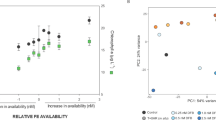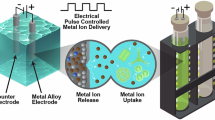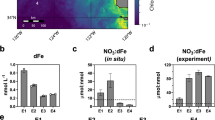Abstract
Phytoplankton are often limited by iron in aquatic environments. Here we examine Fe bioavailability to phytoplankton by analyzing iron uptake from various Fe substrates by several species of phytoplankton grown under conditions of Fe limitation and comparing the measured uptake rate constants (Fe uptake rate/ substrate concentration). When unchelated iron, Fe′, buffered by an excess of the chelating agent EDTA is used as the Fe substrate, the uptake rate constants of all the eukaryotic phytoplankton species are tightly correlated and proportional to their respective surface areas (S.A.). The same is true when FeDFB is the substrate, but the corresponding uptake constants are one thousand times smaller than for Fe′. The uptake rate constants for the other substrates we examined fall mostly between the values for Fe′ and FeDFB for the same S.A. These two model substrates thus empirically define a bioavailability envelope with Fe′ at the upper and FeDFB at the lower limit of iron bioavailability. This envelope provides a convenient framework to compare the relative bioavailabilities of various Fe substrates to eukaryotic phytoplankton and the Fe uptake abilities of different phytoplankton species. Compared with eukaryotic species, cyanobacteria have similar uptake constants for Fe′ but lower ones for FeDFB. The unique relationship between the uptake rate constants and the S.A. of phytoplankton species suggests that the uptake rate constant of Fe-limited phytoplankton has reached a universal upper limit and provides insight into the underlying uptake mechanism.
Similar content being viewed by others
Log in or create a free account to read this content
Gain free access to this article, as well as selected content from this journal and more on nature.com
or
References
Allen AE, LaRoche J, Maheswari U, Lommer M, Schauer N, Lopez PJ et al. (2008). Whole-cell response of the pennate diatom Phaeodactylum tricornutum to iron starvation. Proc Natl Acad Sci USA 105: 10438–10443.
Allnutt FCT, Bonner WD . (1987). Evaluation of reductive release as a mechanism for iron uptake from ferrioxamine B by Chlorella vulgaris. Plant Physiol 85: 751–756.
Amin SA, Green DH, Hart MC, Küpper FC, Sunda WG, Carrano CJ . (2009). Photolysis of iron siderophore chelates promotes bacterial algal mutualism. Proc Natl Acad Sci USA 106: 17071–17076.
Aristilde L, Xu Y, Morel FMM . (2012). Weak organic ligands enhance zinc uptake in marine phytoplankton. Environ Sci Technol 46: 5438–5445.
Barbeau K, Rue EL, Bruland KW, Butler A . (2001). Photochemical cycling of iron in the surface ocean mediated by microbial iron (III)-binding ligands. Nature 413: 409–413.
Borer PM, Sulzberger B, Reichard P, Kraemer SM . (2005). Effect of siderophores on the light-induced dissolution of colloidal iron (III)(hydr) oxides. Mar Chem 93: 179–193.
Boyd PW, Jickells T, Law CS, Blain S, Boyle EA, Buesseler KO et al. (2007). Mesoscale iron enrichment experiments 1993–2005: synthesis and future directions. Science 315: 612–617.
Brand LE . (1991). Minimum iron requirements of marine phytoplankton and the implications for the biogeochemical control of new production. Limnol Oceanogr 36: 1756–1771.
Chen M, Dei RCH, Wang W-X, Guo L . (2003). Marine diatom uptake of iron bound with natural colloids of different origins. Mar Chem 81: 177–189.
Chen M, Wang W-X . (2008). Accelerated uptake by phytoplankton of iron bound to humic acids. Aquat Biol 3: 155–166.
Eckhardt U, Buckhout TJ . (1998). Iron assimilation in Chlamydomonas reinhardtii involves ferric reduction and is similar to Strategy I higher plants. J Exp Bot 49: 1219–1226.
Gervais F, Riebesell U, Gorbunov MY . (2002). Changes in primary productivity and chlorophyll a in response to iron fertilization in the Southern Polar Frontal Zone. Limnol Oceanogr 47: 1324–1335.
Gledhill M, van den Berg CMG . (1994). Determination of complexation of iron (III) with natural organic complexing ligands in seawater using cathodic stripping voltammetry. Mar Chem 47: 41–54.
Gledhill M, Buck KN . (2012). The organic complexation of iron in the marine environment: a review. Front Microbiol 3.
Gustafsson Jon, Petter . (2010). Visual MINTEQ, 3.0 edn. Available at http://www2.lwr.kth.se/English/Oursoftware/vminteq/.
Hassler CS, Schoemann V . (2009). Bioavailability of organically bound Fe to model phytoplankton of the Southern Ocean. Biogeosciences 6: 2281–2296.
Hopkinson BM, Morel FMM . (2009). The role of siderophores in iron acquisition by photosynthetic marine microorganisms. Biometals 22: 659–669.
Hopkinson BM, Barbeau KA . (2012). Iron transporters in marine prokaryotic genomes and metagenomes. Environ Microbiol 14: 114–128.
Hudson RJM, Morel FMM . (1990). Iron transport in marine phytoplankton: kinetics of cellular and medium coordination reactions. Limnol Oceanogr 35: 1002–1020.
Hudson RJM, Covault DT, Morel FMM . (1992). Investigations of iron coordination and redox reactions in seawater using 59Fe radiometry and ion-pair solvent extraction of amphiphilic iron complexes. Mar Chem 38: 209–235.
Hudson RJM, Morel FMM . (1993). Trace metal transport by marine microorganisms: implications of metal coordination kinetics. Deep Sea Res Pt I 40: 129–150.
Hutchins DA, Witter AE, Butler A, Luther GW . (1999). Competition among marine phytoplankton for different chelated iron species. Nature 400: 858–861.
Johnson KS, Gordon RM, Coale KH . (1997). What controls dissolved iron concentrations in the world ocean? Mar Chem 57: 137–161.
Jones GJ, Palenik BP, Morel FMM . (1987). Trace metal reduction by phytoplankton: the role of plasmalemma redox enzymes. J Phycol 23: 237–244.
Kraemer SM . (2004). Iron oxide dissolution and solubility in the presence of siderophores. Aquat Sci 66: 3–18.
Kranzler C, Lis H, Shaked Y, Keren N . (2011). The role of reduction in iron uptake processes in a unicellular, planktonic cyanobacterium. Environ Microbiol 13: 2990–2999.
Kranzler C, Lis H, Finkel OM, Schmetterer G, Shaked Y, Keren N . (2014). Coordinated transporter activity shapes high-affinity iron acquisition in cyanobacteria. ISME J 8: 409–417.
Kuma K, Matsunaga K . (1995). Availability of colloidal ferric oxides to coastal marine phytoplankton. Mar Biol 122: 1–11.
Kustka AB, Shaked Y, Milligan AJ, King DW, Morel FMM . (2005). Extracellular production of superoxide by marine diatoms: contrasting effects on iron redox chemistry and bioavailability. Limnol Oceanogr 50: 1172–1180.
Kustka AB, Allen AE, Morel FMM . (2007). Sequence analysis and transcriptional regulation of iron acquisition genes in two marine diatoms. J Phycol 43: 715–729.
Lammers PJ, Sanders-Loehr J . (1982). Active transport of ferric schizokinen in Anabaena sp. J Bacteriol 151: 288–294.
Lane ES, Semeniuk DM, Strzepek RF, Cullen JT, Maldonado MT . (2009). Effects of iron limitation on intracellular cadmium of cultured phytoplankton: implications for surface dissolved cadmium to phosphate ratios. Mar Chem 115: 155–162.
Lis H, Shaked Y . (2009). Probing the bioavailability of organically bound iron: a case study in the Synechococcus-rich waters of the Gulf of Aqaba. Aquat Microb Ecol 56: 241–267.
Maldonado MT, Price NM . (1996). Influence of N substrate on Fe requirements of marine centric diatoms. Mar Ecol Prog Ser 141: 161–172.
Maldonado MT, Price NM . (2001). Reduction and transport of organically bound iron by Thalassiosira Oceanica (Bacillariophyceae). J Phycol 37: 298–310.
Maldonado MT, Strzepek RF, Sander S, Boyd PW . (2005). Acquisition of iron bound to strong organic complexes, with different Fe binding groups and photochemical reactivities, by plankton communities in Fe-limited subantarctic waters. Global Biogeochem Cy 19: GB4S23.
Maldonado MT, Allen AE, Chong JS, Lin K, Leus D, Karpenko N et al. (2006). Copper-dependent iron transport in coastal and oceanic diatoms. Limnol Oceanogr 51: 1729–1743.
Mann EL, Chisholm SW . (2000). Iron limits the cell division rate of Prochlorococcus in the eastern equatorial Pacific. Limnol Oceanogr 45: 1067–1076.
Marchetti A, Maldonado MT, Lane ES, Harrison PJ . (2006). Iron requirements of the pennate diatom Pseudonitzschia: comparison of oceanic (high-nitrate, low-chlorophyll waters) and coastal species. Limnol Oceanogr 51: 2092–2101.
Martin JH, Fitzwater S . (1988). Iron deficiency limits phytoplankton growth in the north-east Pacific subarctic. Nature 331: 947–975.
Martin JH . (1990). Glacial‐interglacial CO2 change: the iron hypothesis. Paleoceanography 5: 1–13.
Martin JH, Gordon RM, Fitzwater SE . (1991). The case for iron. Limnol Oceanogr 36: 1793–1802.
McKay RML, Bullerjahn GS, Porta D, Brown ET, Sherrell RM, Smutka TM et al. (2004). Consideration of the bioavailability of iron in the North American Great Lakes: development of novel approaches toward understanding iron biogeochemistry. Aquat Ecosyst Health 7: 475–490.
Millero FJ . (1998). Solubility of Fe (III) in seawater. Earth Planet Sci Lett 154: 323–329.
Moore JK, Doney SC, Glover DM, Fung IY . (2001). Iron cycling and nutrient-limitation patterns in surface waters of the World Ocean. Deep Sea Res Pt II 49: 463–507.
Morel FMM, Kustka AB, Shaked Y . (2008). The role of unchelated Fe in the iron nutrition of phytoplankton. Limnol Oceanogr 53: 400.
Morel FMM, Hering JG . (1993) Principles and Applications of Aquatic Chemistry. John Wiley & Sons.
Nodwell LM, Price NM . (2001). Direct use of inorganic colloidal iron by marine mixotrophic phytoplankton. Limnol Oceanogr 46: 765–777.
North RL, Guildford SJ, Smith REH, Havens SM, Twiss MR . (2007). Evidence for phosphorus, nitrogen, and iron colimitation of phytoplankton communities in Lake Erie. Limnol Oceanogr 52: 315–328.
Pierre JL, Fontecave M, Crichton RR . (2002). Chemistry for an essential biological process: the reduction of ferric iron. Biometals 15: 341–346.
Raven JA, Evans MC, Korb RE . (1999). The role of trace metals in photosynthetic electron transport in O2-evolving organisms. Photosynth Res 60: 111–150.
Rubin M, Berman-Frank I, Shaked Y . (2011). Dust-and mineral-iron utilization by the marine dinitrogen-fixer Trichodesmium. Nat Geosci 4: 529–534.
Rue EL, Bruland KW . (1995). Complexation of iron (III) by natural organic ligands in the Central North Pacific as determined by a new competitive ligand equilibration/adsorptive cathodic stripping voltammetric method. Mar Chem 50: 117–138.
Salmon TP, Rose AL, Neilan BA, Waite TD . (2006). The FeL model of iron acquisition: Nondissociative reduction of ferric complexes in the marine environment. Limnol Oceanogr 51: 1744–1754.
Shaked Y, Kustka AB, Morel FMM, Erel Y . (2004). Simultaneous determination of iron reduction and uptake by phytoplankton. Limnol Oceanogr Methods 2: 137–145.
Shaked Y, Kustka AB, Morel FMM . (2005). A general kinetic model for iron acquisition by eukaryotic phytoplankton. Limnol Oceanogr 50: 872–882.
Shaked Y, Lis H . (2012). Disassembling iron availability to phytoplankton. Front Microbiol 3: 1–26.
Shi D, Xu Y, Hopkinson BM, Morel FMM . (2010). Effect of ocean acidification on iron availability to marine phytoplankton. Science 327: 676–679.
Strzepek RF, Maldonado MT, Hunter KA, Frew RD, Boyd PW . (2011). Adaptive strategies by Southern Ocean phytoplankton to lessen iron limitation: Uptake of organically complexed iron and reduced cellular iron requirements. Limnol Oceanogr 56: 1983.
Sulzberger B, Suter D, Siffert C, Banwart S, Stumm W . (1989). Dissolution of Fe (III)(hydr) oxides in natural waters; laboratory assessment on the kinetics controlled by surface coordination. Mar Chem 28: 127–144.
Sunda WG, Huntsman SA . (1995). Iron uptake and growth limitation in oceanic and coastal phytoplankton. Mar Chem 50: 189–206.
Sunda WG, Huntsman SA . (1997). Interrelated influence of iron, light and cell size on marine phytoplankton growth. Nature 390: 389–392.
Sunda WG, Price NM, Morel FMM . (2005). Trace metal ion buffers and their use in culture studies. In: Anderson RA, (ed). Algal Culturing Techniques. Elsevier Academic Press: Burlington, MA, USA, pp 35–63.
Thompson AW . (2009). Iron and prochlorococcus. PhD thesis, Massachusetts Institute of Technology, Cambridge, MA.
Wu J, Luther GW III . (1995). Complexation of Fe (III) by natural organic ligands in the Northwest Atlantic Ocean by a competitive ligand equilibration method and a kinetic approach. Mar Chem 50: 159–177.
Wu J, Boyle E, Sunda WG, Wen LG . (2001). Soluble and colloidal iron in the oligotrophic North Atlantic and North Pacific. Science 293: 847–849.
Acknowledgements
We wish to thank A Rose, B Lazar and Y Rosenberg for their insights and assistance during the preparation of this manuscript as well as the reviewers and editor for their valuable comments. This work was supported in part by the Israel USA Binational Science Foundation grant 2008097 awarded to FMMM and YS, a grant the US National Science Foundation awarded to FMMM, grant 806/11 from the Israeli Science Foundation awarded to NK and the Assemble FP7 research grant awarded to HL.
Author information
Authors and Affiliations
Corresponding author
Ethics declarations
Competing interests
The authors declare no conflict of interest.
Additional information
Supplementary Information accompanies this paper on The ISME Journal website
Rights and permissions
About this article
Cite this article
Lis, H., Shaked, Y., Kranzler, C. et al. Iron bioavailability to phytoplankton: an empirical approach. ISME J 9, 1003–1013 (2015). https://doi.org/10.1038/ismej.2014.199
Received:
Revised:
Accepted:
Published:
Issue date:
DOI: https://doi.org/10.1038/ismej.2014.199
This article is cited by
-
Cyanobacterial blooms, iron, and environmental pollutants
BioMetals (2023)
-
First report on biological iron uptake in the Antarctic sea-ice environment
Polar Biology (2023)
-
Effect of dissolved iron (II) and temperature on growth of the Southern Ocean phytoplankton species Fragilariopsis cylindrus and Phaeocystis antarctica
Polar Biology (2023)
-
Pack-ice seals contribute to biological transfers of iron in the Southern Ocean
Polar Biology (2023)
-
Single-cell measurements and modelling reveal substantial organic carbon acquisition by Prochlorococcus
Nature Microbiology (2022)



